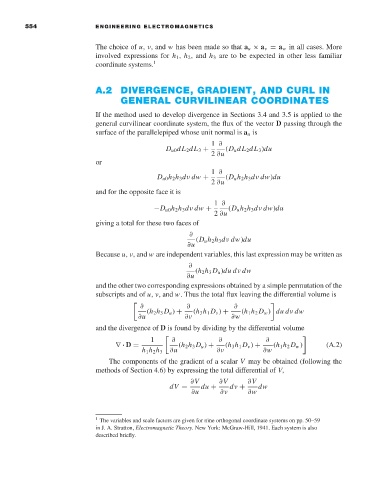Page 572 - Engineering Electromagnetics, 8th Edition
P. 572
554 ENGINEERING ELECTROMAGNETICS
The choice of u, ν, and w has been made so that a u × a ν = a w in all cases. More
involved expressions for h 1 , h 2 , and h 3 are to be expected in other less familiar
coordinate systems. 1
A.2 DIVERGENCE, GRADIENT, AND CURL IN
GENERAL CURVILINEAR COORDINATES
If the method used to develop divergence in Sections 3.4 and 3.5 is applied to the
general curvilinear coordinate system, the flux of the vector D passing through the
surface of the parallelepiped whose unit normal is a u is
1 ∂
D u0 dL 2 dL 3 + (D u dL 2 dL 3 )du
2 ∂u
or
1 ∂
D u0 h 2 h 3 dν dw + (D u h 2 h 3 dν dw)du
2 ∂u
and for the opposite face it is
1 ∂
−D u0 h 2 h 3 dν dw + (D u h 2 h 3 dν dw)du
2 ∂u
giving a total for these two faces of
∂ (D u h 2 h 3 dν dw)du
∂u
Because u, ν, and w are independent variables, this last expression may be written as
∂
(h 2 h 3 D u )du dν dw
∂u
and the other two corresponding expressions obtained by a simple permutation of the
subscripts and of u, ν, and w. Thus the total flux leaving the differential volume is
∂ ∂ ∂
(h 2 h 3 D u ) + (h 3 h 1 D ν ) + (h 1 h 2 D w ) du dν dw
∂u ∂v ∂w
and the divergence of D is found by dividing by the differential volume
1 ∂ ∂ ∂
∇ · D = (h 2 h 3 D u ) + (h 3 h 1 D ν ) + (h 1 h 2 D w ) (A.2)
h 1 h 2 h 3 ∂u ∂ν ∂w
The components of the gradient of a scalar V may be obtained (following the
methods of Section 4.6) by expressing the total differential of V,
∂V ∂V ∂V
dV = du + dν + dw
∂u ∂ν ∂w
1 The variables and scale factors are given for nine orthogonal coordinate systems on pp. 50–59
in J. A. Stratton, Electromagnetic Theory.New York: McGraw-Hill, 1941. Each system is also
described briefly.

